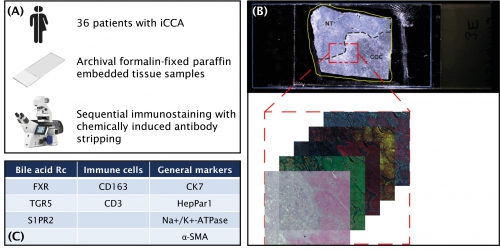CS5: Characterisation of the cellular expression pattern of bile acid receptors in intrahepatic cholangiocellular carcinoma
|
|
Cholangiocellular carcinoma (CCA) remains asymptomatic for a long time and is therefore often only diagnosed at a locally advanced or metastatic stage. The low response rates to conventional chemotherapy combined with pronounced side effects highlight the need for new therapeutic approaches in CCA. Although several risk factors have already been identified, the pathogenesis of CCA remains largely unexplained. Bile acids may play a key role in the development of CCA. Besides being involved in fat digestion and absorption, they are important signalling molecules. They exert their effects by binding to nuclear as well as membrane-bound G-protein-coupled receptors. Important receptors include the farnesoid X receptor (FXR), the Takeda G protein-coupled receptor 5 (TGR5, GPBAR1) and the sphingosine-1-phosphate receptor 2 (S1PR2). While TGR5 and S1PR2 are increasingly expressed in CCA, FXR is downregulated. It has already been shown that bile acids can induce hepatic inflammation and biliary proliferation via their specific receptors and thus indirectly contribute to the development of CCA. Interestingly, bile acid receptors can be addressed pharmacologically, making them a potential target for specific tumour therapy. In human intrahepatic CCA cells, the FXR agonist obeticholic acid, already approved for the treatment of primary biliary cholangitis, showed an antiproliferative effect on tumour cells. Nevertheless, the spatial expression pattern of the different bile acid receptors in human CCA and adjacent non-tumour tissue is unknown, especially regarding the different cell types present in the tumour such as cholangiocytes, immune cells or fibroblasts. However, this knowledge could be the cornerstone of potential new bile acid receptor-associated therapeutic strategies in CCA. In our research project, we will investigate the expression of bile acid receptors in human tissue samples of intrahepatic CCA (iCCA) and adjacent non-tumour tissue by immunostaining. A special staining technique called multiplex immunostaining will be used. This technique allows the simultaneous staining of several antigens on a single tissue section, thus enabling not only the quantification of target structures but also the investigation of their localisation and spatial relationships. By means of specific co-staining cell types can be distinguished and thus the expression of the antigens investigated can be recorded at the cellular level. Therefore, it will be possible to shed light on the tumour microenvironment of iCCA, consisting of immune cells such as macrophages and stromal cells, the so-called cancer-associated fibroblasts (CAFs), as well as adjacent non-tumour tissue, with a particular focus on the expression of bile acid receptors. A major advantage of the multiplex immunostaining protocol is the use of formalin-fixed paraffin embedded tissue samples as starting material. A large registry of CCA patients together with histopathological material is available. Therefore, the experimental results will be correlated with clinical parameters such as response to therapy or survival. A better understanding of the cellular expression pattern of bile acid receptors in iCCA is the central aim of this project. The knowledge gained will then be used to further study the role of bile acid receptors in carcinogenesis mechanistically using in vitro approaches (cell co-culture, biliary spheroids/organoids, iCCA mouse models). The overriding goal is always to apply this knowledge to the development of new therapeutic strategies.
|
Photos: by UMMD, Melitta Schubert/Sarah Kossmann








